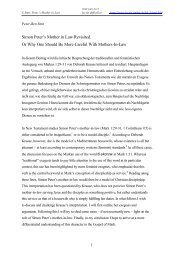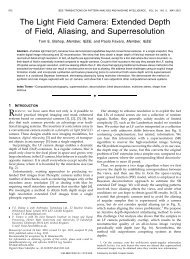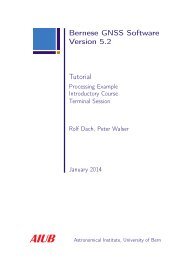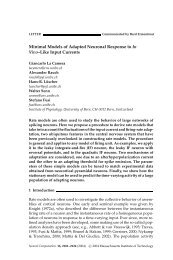Deploying Real-Life WSN Applications: Challenges ... - IAM - CDS
Deploying Real-Life WSN Applications: Challenges ... - IAM - CDS
Deploying Real-Life WSN Applications: Challenges ... - IAM - CDS
Create successful ePaper yourself
Turn your PDF publications into a flip-book with our unique Google optimized e-Paper software.
International Journal of Distributed Sensor Networks 11<br />
∗<br />
compare path reliability and required network retransmission limitation ∗ /<br />
If (R AB > BR AB )<br />
{<br />
if (RT i ≤ NT i )<br />
Forward Data (B, X, Data); // ACK imp<br />
else // RT i > NT i<br />
Forward Data (B, X, Data, ACK); // ACK dir<br />
}<br />
else // R AB ≤ BR AB<br />
{<br />
if (RT i ≤ NT i )<br />
Forward Data (B, X, Data, ACK); // ACK dir<br />
else // (RT i ≤ NT i )<br />
Forward Data (B, X, Data, ACK); // ACK dir<br />
}<br />
Algorithm 1: Selective ACK algorithm.<br />
/ ∗ Change base reliability ∗ /<br />
// use ACK imp , good path quality<br />
If (R AB > BR AB )<br />
if (B,RecvData(A))<br />
{<br />
BR AB = BR AB ; // success: maintain base reliability<br />
Clear Buffer (A); // success: clear A buffer<br />
}<br />
else<br />
BR AB = R AB ; // fail: increase base reliability<br />
// use ACK dir , bad path quality<br />
Else // R AB ≤ BR AB<br />
if (B,RecvData(A))<br />
{<br />
BR AB = R AB ; // success : decrease base reliability<br />
Clear Buffer (A); // success: clear A buffer<br />
}<br />
else<br />
BR AB = BR AB ; // fail: maintain base reliability<br />
Algorithm 2: Base reliability change algorithm.<br />
Scenario 4: R AB ≤ BR AB && R BX ≤ BR BX . In the last<br />
scenario, the quality of path A-B-X is poor. Node B sends an<br />
ACK dir message when B receives data from A. Node X sends<br />
an ACK dir message when X receives data from B. In this case,<br />
path quality is disqualified for ACK imp , and thus an ACK dir<br />
message is highly recommended. When node A transfers data<br />
to B after deciding between ACK dir and ACK imp algorithms,<br />
node B initiates a delegation process as described in the third<br />
scenario. If A requests ACK dir because the path reliability<br />
is poor, B must decide whether to use ACK immediately<br />
or to delegate ACK. If the current path reliability is better<br />
than the base reliability, data dissemination will succeed even<br />
though there are no ACK requests. Node B then compares the<br />
base reliability to the next path reliability to decide whether<br />
to delegate. In this case, one node request ACK dir from a<br />
former node and, if the next path reliability is higher than<br />
the base reliability, the node delegates ACK dir to the next<br />
node.<br />
3.9. Update Base Reliability. After ACK dir or ACK imp selection,<br />
the type of ACK is marked and data is sent. Based<br />
on the success or failure of data transfer, the base reliability<br />
is changed. This base reliability change reflects current<br />
network and node conditions. The base reliability updates<br />
the algorithm for node A-B as shown in Algorithm 2.<br />
If data transfer succeeds with ACK imp (meaning good<br />
path quality), base reliability is maintained. Otherwise,<br />
we need to replace the base reliability with the current<br />
path reliability. Likewise, if data transfer succeeds with<br />
ACK dir (meaning poor network quality), we update the base<br />
reliability with the current path reliability. If data transfer<br />
fails, we maintain the base reliability.<br />
4. Use Case<br />
In LiReTa, the data transfer procedure chooses the type of<br />
ACK to guarantee reliability: ACK dir or ACK imp . In addition,

















